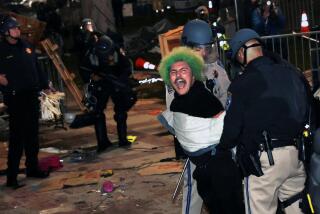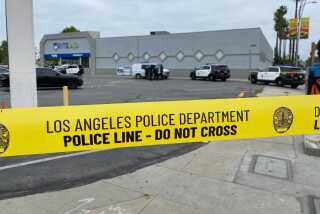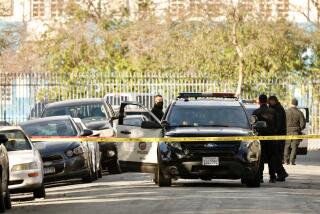With Beanbags, Police Shoot Not to Kill
- Share via
Garden Grove police officers recently were called to a mobile home park to check out reports of a fight when they came across a confrontational 14-year-old boy who kept shouting, “Kill me! Shoot me!” and refused to remove his hand from his front pocket.
The tense scenario could have forced the officers to pull their guns and shoot the teen. But instead, one officer fired a beanbag round from a special shotgun. The bag hit the boy in the abdomen, knocking him down and enabling police to arrest him.
Shotgun-fired beanbags are just one of a growing number of nonlethal weapons that officers across Orange County are using during confrontations with suspects.
The idea behind the new breed of weapons is to temporarily disable criminals without resorting to regular guns. The beanbag shotgun is most often used in situations in which a suspect is unarmed but still poses a threat to officers or others.
In the Garden Grove case, the beanbag shot proved effective in defusing a violent situation. But nonlethal firepower doesn’t always work.
Huntington Beach police said they struggled in November to find ways to subdue a suspected carjacker whom officers ultimately gunned down when he rushed them with a knife in his hand.
Before the shooting, officers tried pepper spray, shotgun-launched beanbag rounds, a police dog and darts that carried an electric jolt to take down the man. But all their efforts failed to coax the man out of the van that he allegedly stole at knifepoint.
About 32 SWAT officers in the Santa Ana Police Department carry the beanbag rounds, but none have yet found an occasion to use them, training Sgt. Tony Levatino said.
Officials said the beanbag projectiles are important because they give police one more alternative to using their guns.
“The lowest level officers use is verbal commands,” Levatino said. “The next level is pain and compliance holds and chemical agents. Then there’s body weapons like kicking and punching [and] the baton. You also have Taser [guns], canine units and beanbag rounds. The final level is deadly force.”
The 1 1/4-inch-long beanbags are folded into shotgun shells. When the shell is fired, the beanbag exits the shell and hits the suspect, usually causing temporary incapacity and severe pain. Officials said the impact is like being hit with a baseball pitch.
Critics argue that the beanbags are still very dangerous and that police should consider other methods of subduing criminals.
“A nonprojectile alternative is the best way to go,” said James Bridges, executive director of the Citizens Bureau of Investigation, a Huntington Beach police and government watchdog group. “A beanbag might sound a lot safer than a bullet, but a projectile is a projectile is a projectile.”
Police, however, express satisfaction with the beanbags. The incident in the Garden Grove mobile home park marked the third time that the city’s Police Department had turned to the device.
“The officers on scene are to be commended for the restraint,” Lt. John Woods said.
(BEGIN TEXT OF INFOBOX / INFOGRAPHIC)
Avoiding Deadly Force
Shotgun-fired bean bags allow police to temporarily incapacitate suspects instead of killing them. Most suspects fall in pain, thinking they have been hit by a regular shotgun round.
Bag (1 1/4 inches) of lead shot is loaded by manufacturer into 12-gauge shotgun shell:
Lead shot (40 grams or about 1 1/2 ounces)
How They Work
1. Lead shot sewn into small canvas bag.
2. Bag folded . . .
. . . and inserted into shotgun shell.
3. Shell crimped shut.
4. Bean bag round loaded into regular 12-gauge shotgun.
5. Gun is fired, bean bag exits shell and travels through gun barrel.
6. Bag unfolds and flattens when it leaves barrel.
7. When bag strikes suspect it’s comparable to being struck by a major-league baseball pitch.
IN COMPARISON: speeds of police ammunition
Bean bags
Velocity: 280-300 feet per second
Effective range: 20-75 feet
*
9mm bullet
Velocity: 975 feet per second
Effective range: Up to 75 yards
*
.45-caliber bullet
Velocity: 950 feet per second
Effective range: Up to 75 yards
*
.38-caliber bullet
Velocity: 1,000 feet per second
Effective range: Up to 75 yards
*
12-gauge double-ought buckshot
Velocity: 1,200 feet per second
Effective range: Up to 25 yards
*
12-gauge shotgun slug
Velocity: 1,500 feet per second
Effective range: Up to 25 yards
BEANBAG PROTOCOL
Procedures vary among agencies, but the following practices are common:
* Bean bag equipment is issued only to supervisory officers, who decide when to deploy it.
* Although bags can be fired from any 12-gauge shotgun, most departments designate weapons for bean bag use by painting portions of the guns light gray. This reduces chances of firing a regular round left in the shotgun by accident.
* A back-up armed with regular ammunition is positioned alongside the officer firing the bean bag. The back-up officer aims at suspect, but does not fire unless the bag fails and suspect becomes an immediate threat.
Where to Strike
Officers are trained to aim for the suspect’s lower body.
Sources: Anaheim Police Dept.
Graphics reporting by JANICE JONES DODDS/Los Angeles Times
More to Read
Sign up for Essential California
The most important California stories and recommendations in your inbox every morning.
You may occasionally receive promotional content from the Los Angeles Times.










